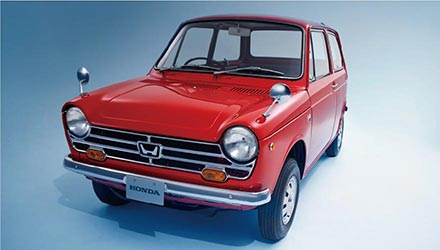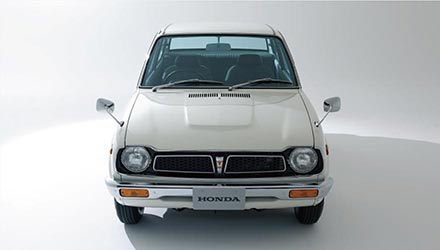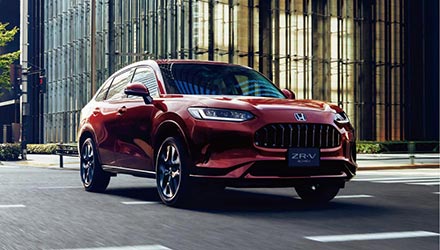Entering Automobile Market
with Japan’s First Water-cooled DOHC Engine
 S500’s AS280E 492 cc, water-cooled, inline 4-cylinder DOHC engine
S500’s AS280E 492 cc, water-cooled, inline 4-cylinder DOHC engine
In 1963, Honda entered the automobile market with its first model, the T360, followed by the S500. First releasing a truck, useful for work, and a sports car, had been described as symbolic of Honda’s character. The engines that powered these two models were water-cooled inline four-cylinder DOHC engines with displacements of 360 cc and 500 cc respectively. They were made entirely of aluminum, and in order to achieve high engine speed and output, CV quad carburetors were installed in the intake system, and so-called “octopus legs”*1 for the exhaust system. The T360’s AK250E engine had a maximum output of 30 PS/8,500 rpm and a maximum torque of 2.7 kgf/6,000 rpm.
- Pipes to the exhaust manifold were intertwined like octopus legs to ensure equal length, to increase horse power.
Honda’s Commitment to Air-cooled Engines
 N360’s N360E 354 cc air-cooled inline
N360’s N360E 354 cc air-cooled inline 2-cylinder SOHC engine
 1300’s H1300E 1,298 cc DDAC (air-cooled) inline
1300’s H1300E 1,298 cc DDAC (air-cooled) inline 4-cylinder SOHC engine
The next engine Honda developed, the N360E which powered the N360 k-car, was based on the 4-stroke, parallel 2-cylinder DOHC 450 cc engine of the Dream CB450 motorcycle. It was a high-revving, high-output SOHC 354 cc engine with a maximum output of 31 PS at 8,500 rpm, atypical as an automobile engine, but typically Honda.
Honda’s commitment to air-cooled engines came from founder Soichiro Honda’s insistence that in the end, air cools the water used in water-cooled engines, so it made sense to just cool the engine with air. There would be no need to worry about leaks, and maintenance would be easier.
The air-cooled engine was also used in the 1300. Development of the 1.3L air-cooled inline 4-cylinder SOHC engine was led by none other than Soichiro himself. His instructions were to “develop a high output, luxury sedan, front-wheel drive [FWD] car with an original air-cooled engine.” At the same time, Soichiro also gave the order to develop an air-cooled engine for the F1TM World Championship. He wanted to prove through F1 that air-cooled engines would be the future of world-class cars, and to expand the use of air-cooled engines to commercial vehicles.
The 1300 was highly acclaimed technologically, but it was difficult to gain customer support due to various issues. In 1970, in the face of this reality and in anticipation of increasing demand for environmental performance, Honda decided to switch to water-cooled automobile engines.
The 1300 was supposed to be designed from the customer’s point of view, but the technology came to the fore and it became unclear how this car would ultimately be driven, and by what kind of customer. Based on this bitter experience, Kiyoshi Kawashima (later the second president), then president of the Honda R&D, proposed the systemization of development and reform under the leadership of Tadashi Kume (later the third president), then managing director of the R&D Center. This was the origin of the S-E-D evaluation of development steps that is still in use today.
Back to Water-cooled Engines, To Curb Air Pollution
 Due to the success of the Life’s water-cooled engine,
Due to the success of the Life’s water-cooled engine, Honda moved toward water-cooled engines for all of its passenger cars.
The N360, an epoch-making high-performance car, overtook the Subaru 360 in sales just two months after its launch in 1967, and went on to become the top selling k-car model in Japan. While personal demand for automobiles was growing and booming, new social problems such as urban air pollution were emerging. Against this backdrop, Honda had decided to use water-cooled engines in the successor to the N360, based on its experiences with the 1300. The basic configuration of the engine was a water-cooled in-line 2-cylinder SOHC engine with a hemispherical combustion chamber and a cross-flow independent port intake and exhaust system, with a bore and stroke of 67.0 x 50.6 mm, and to reduce camshaft noise, became Japan’s first production engine with a timing belt*2. The belt did not generate high-frequency striking noise like a cam chain, did not require oil lubrication, and could be positioned outside the engine block. The expected life of the timing belt was as long as 80,000 km, contributing greatly to the improvement of engine quality and serviceability.
The success of the Life's use of water-cooled engines led to the introduction of these engines in the Honda Z in December 1971, and the reborn 1300 in November 1972 as the 145 /145 coupe. Honda’s passenger car engines were now entirely water-cooled to meet the needs of the new era.
- Honda research
CVCC: World’s First Engine to Comply with the Muskie Act
 Civic’s CVCC engine
Civic’s CVCC engine
 City’s Combax engine based on the CVCC engine
City’s Combax engine based on the CVCC engine
Honda was committed to solving environmental issues, and in 1972, completed the CVCC engine which complied with the Muskie Act (the U.S. Clean Air Act of 1970). This was a remarkable achievement at a time when the world’s major automobile companies were struggling to meet the challenge. The CVCC engine continued to evolve, with a shift from slow to rapid combustion, and the first-generation City, launched in November 1981, featured the Combax*3 engine, a high-density, high-speed combustion system based on the 1.2-liter inline 4-cylinder SOHC CVCC engine. This engine became the world’s first unleaded gasoline automobile engine to achieve a compression ratio of 10:1*4. Displacement was further expanded to 1.5L and 1.8L engines, but behind the scenes, engineers began to realize the limitations of the CVCC in improving exhaust gas purification performance in response to ever-tightening emissions regulations.
- Compact Blazing Combustion Axiom
- Honda research
High Dynamic and Environmental Performance
Revival of the DOHC Engine After 14 Years
 Civic Si
Civic Si
 Quint Integra
Quint Integra
The engine development team was considering a new engine to follow the CVCC. The order came to engine designer Keiichi Kawada, who had a unique background in designing jigs and other equipment, program design, prototype and mass production process management, and developing V6 racing engines for F2*5. He was given the task of developing a 1.6L inline 4-cylinder SOHC engine that would combine excellent dynamic and environmental performance.
Honda’s philosophy is to develop engines that are cost-competitive and a joy to drive, while meeting environmental performance standards. Kawada strongly shared this belief. At the time, Kawada who drove a CVCC Accord thought, “I want to develop a more fun engine.” His order was for a SOHC engine, but he wanted to create a DOHC engine. Kawada had formed an in-house team and continued to participate in the Civic one-make race since its inception, but he wanted to make an engine that would be able to compete in races where it would win or lose against other manufacturers’ cars.
He then began to prepare drawings for the DOHC, while designing the SOHC as well. Kawada presented both drawings to his superiors, arguing that there was not much difference in size, weight, number of parts, and cost. The sales promotion department supported the DOHC engine as it was more appealing, and the decision was made to go with the 1.6L inline 4-cylinder DOHC engine. The engine model was ZC, and it powered the Civic and CR-X Si grade launched in November 1984, and in the Quint Integra launched in February 1985. For the Quint Integra, the news release announcing its launch included the statement “All models equipped with DOHC engines.” In fact, it was Kawada who asked the sales promotion and public relations departments to back him up.
 1966 F2 engine, the origin of the ZC engine
1966 F2 engine, the origin of the ZC engine
The ZC engine adopted the inner-supported rocker arms, instead of direct push, in which the cam directly pushes the valves. The reason for this was to secure 10.3 mm of lift*6 for the intake valves in order to achieve higher output, which was impossible with direct push. The rocker arm with inner, rather than outer support in order to make the heads more compact.
This idea came from Kawada’s involvement in the restoration of a 1966 1.0L inline 4-cylinder F2 engine*7. Even if the inner-supported rocker arm system was adopted, using a standard rocker shaft would mean the valves had been offset outward by that amount, resulting in a larger valve angle. For performance, the valve angle needs to be as small as possible. This reminded Kawada of the F2 engine. It was an inner-supported pivot rocker-arm DOHC that did not use a rocker shaft. This new and innovative concept led to rapid progress in design. The engine was so focused on high performance that it adopted the world’s first*8 technology to make the camshafts hollow along the cams’ crests to reduce weight, rather than simply hollowing the camshafts out in a cylindrical shape. The driving force behind this commitment was to use the camshafts in races and win. It was truly a typical Honda way of developing, where the engineer worked according to his own beliefs.

Rocker arm used to realize 10.3 mm intake-side lift
 Powered the Civic Si, CR-X Si and Quint Integra
Powered the Civic Si, CR-X Si and Quint Integra 1,598 cc water-cooled inline 4-cylinder DOHC ZC engine
Another major innovation was made to make this engine viable. This is the reduction in the diameter of the hexagonal part, the hex head, of the spark plugs. The conventional 20 mm hex head did not fit, as it would be too close to the rocker arm support. A new slim plug with a 16 mm hex head was developed in cooperation with a domestic plug manufacturer. After this ZC-type engine, this slim spark plug with a compact hex head became popular worldwide.
At the same time, Group A*9 of the Japan Touring Car Championship, a production car race series, had started in Japan. Kawada had designed the ZC engine with the specific goal of increasing the performance of the cylinder heads, crankshaft, and crankshaft journal system to 200 PS in anticipation of competing in these races. However, in order to enter the series, Honda needed to sell at least 5,000 units of the production model that would serve as the basis for the race-entering vehicle. The Quint Integra released in February 1985 was not ready for homologation, and its large body was at a significant disadvantage. Kawada directly convinced Nobuhiko Kawamoto, then president of the Honda R&D, and a ZC engine was added to the Civic Si line in November 1984, clearing the 5,000-unit production hurdle. Kawamoto had only one condition for passing this difficult challenge: “Win the race.”
 Civic Si racing car
Civic Si racing car Competed in the 1987 All Japan Touring Car
Championship Group A
The challenge was a success. In 1985, the Civic was entered in Group A (under 1600 cc) class mid-season, and although it did not win the championship that year, it dominated the series from 1986 to 1993, when the series ended*10. Kawada again directly appealed to Kawamoto to allow him to develop the racing car, and worked on it simultaneously with his other mass production development tasks. In his twenties to thirties, he was young and full of energy, but the culture at Honda also allowed its engineers to take on such challenges, crossing departmental boundaries.
The ZC engine was later developed into the B-series with a larger displacement with 90 mm bore pitch and the same basic structure. 1.8L B18A and 2.0L B20A engines were developed for the Accord and Prelude launched in 1985. Not limited to engines, but in any kind of development, anticipating the future and having a range of possible applications is vital to determine if, and how far, the technology will be developed. This is a test of how deep an engineer thinks.
- Formula 2: FIA formula racing category, immediately below Formula 1. Ended in 1984 with the migration to F3000.
- Valve opening height
- Engine supplied for Brabham F2 team’s BT18
- Honda research
- Class 3 following Division 1 at the time
- Winner of the drivers’ championship from 1986 to 1988 and 1991 to 1993
Winner of the manufacturers’ championship from 1987 to 1993
The 100 PS per Liter VTEC Engine is Born
By developing a Group A racing engine based on the ZC engine, Honda would be able to achieve 100 PS per liter even with a l.6L naturally-aspirated engine. This indicated that the company had acquired the know-how of valve timing, lift, and compression ratio to produce such power. The world's first*11 variable valve timing lift mechanism, VTEC (Variable Valve Timing & Lift Electronic Control System), was developed to combine high-revving, high-output performance with normal engine performance that covered the low-revving range. This technology was based on REV (Revolution Modulated Valve Control), a motorcycle technology that deactivates two valves in a four-valve engine at low speeds.
The 1.6L inline 4-cylinder DOHC B16A engine, which adopted VTEC, achieved 100 PS per liter, and powered the Integra launched in 1989. This news had a huge impact on the industry.

B16A engine equipped with VTEC, which became the core technology for subsequent Honda engines
The rocker arms, which use hydraulic pressure to move pins to change the timing and lift of the valves, required ultra-high-precision machining, and only two companies in Japan had the technology to manufacture VTEC rocker arms as of 2023. VTEC was also applied to the NSX launched in 1990, one year after the Integra, and has since become the core of Honda’s engine technology.
- VTEC is the world’s first (Honda research) dynamic valve train mechanism that can simultaneously change the timing and lift of intake and exhaust valves.

DOHC VTEC mechanism with three cam lobes and rocker arms on each intake and exhaust side





